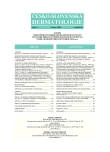Use of Dermatoscopy in the Differential Diagnosis of Non-Melanocytic Lesions and Malignant melanoma
Authors:
T. Fikrle; K. Pizinger
Authors‘ workplace:
Dermatovenerologická klinika LF UK a FN v Plzni
přednosta prof. MUDr. Vladimír Resl, CSc.
Published in:
Čes-slov Derm, 80, 2005, No. 3, p. 162-168
Category:
Clinical and laboratory Research
Overview
Dermatoscopy is a non-invasive diagnostic method used in dermatology to examine pigmented skin lesions in vivo. Its aim is to improve the quality of the differential diagnosis and to lower the number of unnecessary surgical interventions. One possibility of the practical use of dermatoscopy is to differentiate melanocytic and non-melanocytic lesions. Authors point out often examined non-melanocyte lesions in melanoma differential diagnosis. On the basis of their own experience they give an overview of common and rare dermatoscopic findings in particular diagnoses (seborrhoeic wart, pigmented basalioma, vascular and haemorrhagic skin lesions, histiocytoma) including picture documentation obtained by digital dermatoscopy.
Key words:
dermatoscopy – seborrhoeic wart – basalioma – vascular and haemorrhagic lesions
Labels
Dermatology & STDs Paediatric dermatology & STDsArticle was published in
Czech-Slovak Dermatology

2005 Issue 3
Most read in this issue
- Melanoma of the External Ear
- The Significance of Sentinel Node Examination in Melanoma: Part I. A Review
- The Significance of Sentinel Node Examination in Melanoma. Part II: Results of Sentinel Node Examination in a group of 177 patients of The Department of Dermatology of General Teaching Hospital
- Use of Dermatoscopy in the Differential Diagnosis of Non-Melanocytic Lesions and Malignant melanoma
